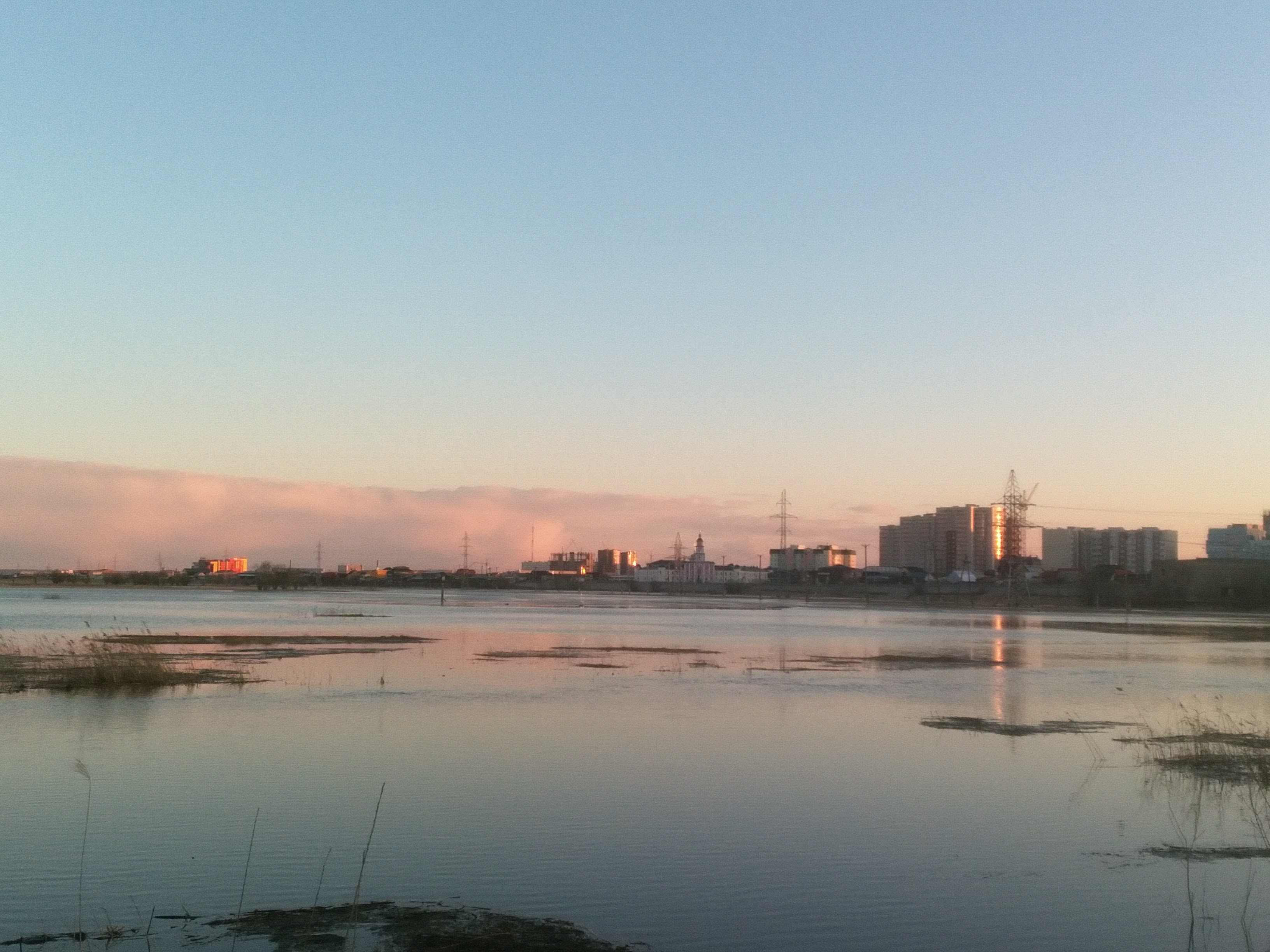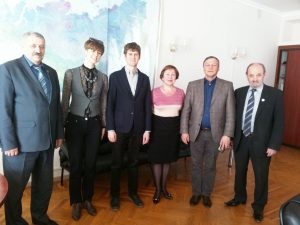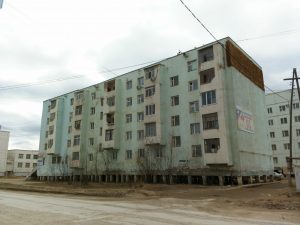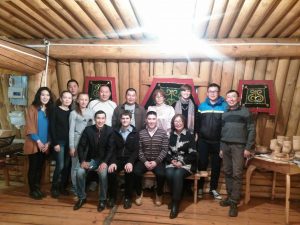By Ksenia Mokrushina – SKOLKOVO Center for Urban Studies, Moscow
The coldest city of its size or larger on the planet, Yakutsk is impressively vibrant and rich in cultural and urban life. Over the past 50 years it experienced an explosive population growth of 300% and is still actively attracting people from neighboring regions. Today, the city is home to over 325 thousand people. Situated on continuous permafrost, Yakutsk has a long-standing experience of design and construction in extreme weather conditions. The city is cut off from the rest of Russia: located on the west bank of the Lena with no bridge, so the city is only accessible for its own citizens, visitors and goods by air, ferry or over the frozen river in the dead of Siberian winter. Although not strictly an arctic city, Yakutsk is the capital of the vast Republic of Sakha (Yakutia), 40% of which lies beyond the North Polar Circle (Figure 1). Five mono-settlements are located in the region, including Mirny on the famous Mir diamond mine and the shrinking coal-mining city Neryungri, second largest in the Republic. The population of the once prosperous northernmost port city of Tiksi has shrunk almost threefold after the collapse of the Soviet Union. Almost 0.5 mln of indigenous people live in Yakutia, out of which 93% are Yakuts, whose well-being and position is the region is continuously improving.

It is the extraordinary nature of large Russian northern cities and their intrinsic relationship with the Artic that brought Brent Ryan of the Massachusetts Institute of Technology (MIT) and Ksenia Mokrushina of the Center for Urban Studies SKOLKOVO to Yakutsk to begin their research on innovation in urban sustainability policy in arctic cities. Brent and Ksenia studied Yakutsk’s experience in urban planning and design, mass housing maintenance and construction in permafrost conditions, and the context, policies and challenges of Yakutian monocities development. An important task of the mission was to identify sources of policy innovation, evaluate the level of accessibility of quantitative and qualitative data, build partnerships with local organizations and institutes to include them in the PIRE network, as well as research educational outreach efforts later on. They held over 20 meetings with people from the regional government and municipal administration, research institutes and think-tanks, local universities, , representatives of local business and creative industries, and civil society organizations. Among them are the State Commission for the Arctic, Institute for Permafrost Studies, the Center for Strategic Studies, North-Eastern Federal University, Association of Reindeer Herders, etc.
Figure 2: Meetings with representatives from Yakutsk
The team has found out that negative effects of climate change are taking their toll on Yakutsk. Thawing permafrost causes visible deformation of buildings, road surfaces and pavement. The city increasingly suffers from the vagaries of the Lena river, which make the ‘northern delivery’ of food and energy supplies completely unpredictable for Yakutsk and the remote settlements in Arctic Yakutia. The economic losses arising from climate change are becoming evident, although not evaluated by the municipality.
Figure 3: Aged Housing Units in Yakutsk
Upgrading of dilapidated housing stock and ensuring systemic deployment of affordable, energy efficient, solutions in new construction, energy, heating and other municipal services poses a significant urban sustainability challenge for the city. Yakutsk is one of the few large Russian cities that is still struggling to solve the problem of urban slums with absent or poorly functioning heating, water, waste management systems, as well as inadequate transport, food and services access. There are still a lot of run-down wooden barracks built back in 1950-60s as temporary housing for builders of ‘khruschevki’. They are being slowly replaced with new mass housing projects of questionable quality and a lot of people are still trapped there waiting for private developers or the municipal government to relocate them within the framework of federal dilapidated housing relocation program. Effective institutional engagement mechanisms to ensure faster and better quality renovations are clearly missing. Without municipal services and housing policy change the city is unlikely to break the vicious circle of local budget deficits and excessive dependence on federal donations and centralized decision-making.
The city is tackling the challenge of unwelcoming public spaces, streetscapes exacerbated by ubiquitous empty spaces of the khruschevka mass housing design pattern, the sight of worn-out external piping, frightening vacuums in-between stilts under houses, lack of trees and greenery. Local design and architecture companies encouraged by the chief architect of Yakutsk and supported by experts from around Russia including the successful local IT company SINET volunteer to develop design projects for abandoned places, disused park territories and canal embankments. A number of these projects will be financed and implemented as part of the federal government driven program “5 Steps towards a more сomfortable city” that is criticized for a standard beautification approach to local urban design problems in Russian cities.
The same urban beautification program is implemented in monotowns and settlements around Yakutia following federal policy requirements. Planning and realization is hindered though by the lack of local capacity and understanding of the need for better urban environment. The Fund for Monocities Development has been recently established to coordinate federally driven local economy diversification programs, including the establishment of ‘zones of intensified development’ offering advantageous conditions for doing business and investing in monotowns,. Whether the new federal monocity development program will bear fruit, remains to be seen. What’s obvious, however, is that there is not enough locally driven strategic planning and policy innovation, community engagement and proactive approaches to local problem solving.
The team was lucky to visit a village 130 km away from the capital, which gave them a unique opportunity to see the other side of the urbanization challenge in Yakutsk. The village is struggling to retain its younger residents, develop local eco-tourist and farming businesses. However their entrepreneurial spirit is still dominated by the habit of relying on support and directions from the government.
Yakutians see the preservation of their unique local arts, culture, and spirit as the key prerequisite of sustainable development. Indeed, Yakutsk boasts a large number of theaters, museums and art galleries that are well-known in Russia; and the Yakutian film industry has established itself globally. The development of local creative industry is one of city’s strategic goals. Almazergienbank, the largest bank in Yakutia, has made the creative cluster project one of its strategic investments and is actively promoting the themes o around the Republic in cooperation with Calvert 22. The State Arctic Institute for Arts and Culture was established in 2000 with the aim to preserve and develop local cultural heritage. Aysen Nikolaev, the Mayor of Yakutsk, believes creative industries will be the main driver of the city’s economic development.
Everything seems to be taken to the limit in Yakutia: from the seasonal temperature differences of over 100°C to the warmth and hospitality of the northern people. This calls for unconventional, locally sensitized approaches to urban sustainability. Thorough research into sources, drivers and prerequisites for locally grown creative potential is required to make arguments and give recommendations regarding the needed policy action.
Figure 3: Workshop with Local Representatives




